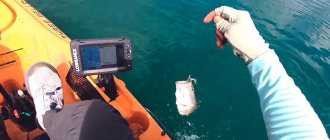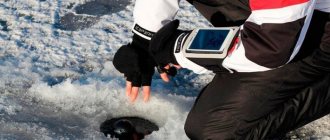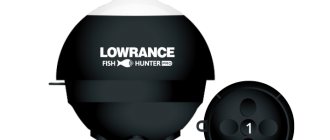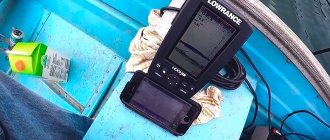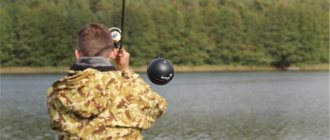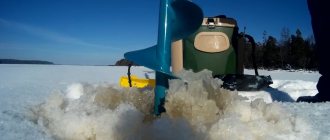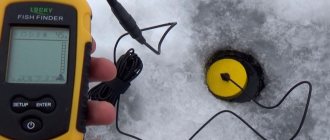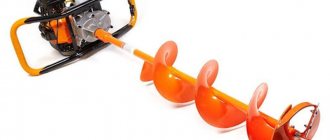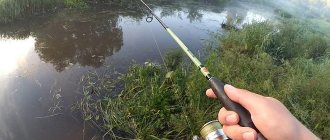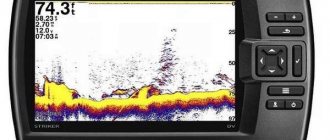Home page ✦ Echo sounders ✦ Choosing an echo sounder Typically, reviews of echo sounders mention expensive and multifunctional devices designed not so much for searching for fish in the river, but for studying the structure of the seabed. Such devices, as a rule, have a very high cost and large dimensions, so if you are choosing an echo sounder to improve fishing performance, you do not have to purchase such devices, because cheaper echo sounders can cope quite well with the tasks that fishermen set for echo sounders. When choosing an echo sounder, first of all you need to decide where and for what the selected echo sounder will be used. There are echo sounders for fishing from the shore; there are specially designed sonars for winter fishing that can operate at low temperatures; and, naturally, the bulk of the assortment consists of echo sounders for fishing from a boat or boat. Today there are many types of echo sounders with different options and subtleties. To choose the right echo sounder, you first need to understand its functionality and understand which option serves what, so as not to overpay extra money for something you don’t need. When choosing an echo sounder, the main thing to consider is the number of beams and its angle. If your main task is to study the bottom topography, then you need to choose an echo sounder with a narrow beam. Such a beam outlines the bottom more accurately and has the least dispersion and distortion. And the price is much cheaper than others. The downside is that it is not a search engine, i.e. he practically does not see the fish, the narrow beam does not have time to catch it. If we talk about a narrow beam, the radiation angle, which is from 9 to 24 degrees, allows you to better view holes, edges, clear relief, and the fish is seen only by those that fall into the narrow beam. This type of echo sounder is more suitable for a very experienced fisherman who knows the nature of the fish and its habitat. If the goal is to see fish, then echo sounders with a wide beam angle are suitable for this. The radiation angle of about 45-90 degrees allows you to see the largest area of the bottom. The greater the depth, the larger the cone of the beam and, accordingly, more fish can be seen. They work best at 85 kHz. The disadvantage of such a beam is that the relief is shown much worse than a narrow beam. For shallow waters, an echo sounder with a wide beam is more suitable. In deep bodies of water, a narrow beam can be used. It is quite enough for viewing the bottom and fish. There are echo sounders, like two in one, i.e. having a narrow beam and a wide one are two beams. There are two beams, a narrow central beam, which operates at a frequency of 200 Hz, and a wide one at a frequency of 85 Hz. He perfectly draws the relief and at the same time views the fish in a wide range. For many dual-beam models, you can turn off the wide beam and use only the narrow beam. This is excellent value for money. There are echo sounders of two, three, four and even five beams, with side-view sensors, a forward-looking beam, so that when moving a boat, you can see an obstacle ahead. Of course, you have to pay extra for all these features. Many fishermen, when choosing an echo sounder, do not take seriously the function of water temperature, which is extremely important. Water temperature and fish nutrition are very interconnected. It is known that when the temperature changes, the fish bite much worse. Simply put, using a temperature sensor you can find out why the fish stopped biting.
⛵ Display. Three main display parameters.
Humminbird Display Replacement
Display resolution is a very important point when choosing a fish finder. The display image consists of pixels, i.e. points. It is designated, for example, “640x640”, which means 640 pixels horizontally and 640 pixels vertically and, like a chessboard, they are a network of tiny dots (pixels) that darken when an electric discharge is applied to them. The more pixels, the higher the display resolution, the clearer the picture, the easier it is to obtain visual information and the more convenient it is to use. With low resolution it can even be difficult to distinguish fish, because at great depths it appears in the form of a square, but with high resolution you can clearly see not only fish, but even algae and driftwood. With the maximum number of points, the zoom function works better. If you fish in shallow waters, then you can do without a huge number of pixels. For greater depths, the more pixels the better. Some echo sounders have the ability to display the so-called “real bottom picture”, when we see a photorealistic image on the display screen of the echo sounder. These models of echo sounders for fishing are quite expensive, but they are capable of showing not only the bottom, but also objects on the bottom, highlighting fish separately, the thermocline zone, and all this on one screen and with high resolution. Such echo sounders operate at shallower depths than conventional fishing echo sounders; the sonar output power is greater, which means energy consumption increases.
The display size, along with the resolution, is also an important parameter of the fish finder. The larger the display size, the clearer the image. The advantage of a large screen is also the ability to divide it into windows to display additional information.
Number of shades of gray. The third parameter of the echo sounder display, which plays an important role in obtaining the clearest and most detailed picture of the image in monochrome displays. The gray level determines the density of the imaged object. The human eye can distinguish 16 gradations of gray, the same number of gradations a monochrome (black and white) display of a good echo sounder can have. A display with a minimum of grayscale is not able to display many objects of a certain density or depicts them in an exaggerated manner. Many novice fish finders are confused by the way objects are displayed on displays with different gray levels. As a rule, the image on a display with a low gray level is more contrasty and clear, but it is easy to guess that such displays depict objects in a simplified way and nothing more. Currently, echo sounders are produced with a monochrome screen from 4 to 16 levels of gray. Echo sounders with a color display are not for everyone. Echo sounders equipped with a color display display objects in 256 color shades (TFT technology). This is the most advanced image transmission technology. I don’t know how necessary exactly 256 color shades are when studying the bottom and thickness of the water, but the positive effect, as they say, is “impressive.” When choosing a black-and-white or color echo sounder of the same price category, it is better to give preference to a black-and-white echo sounder over a color one, because it will have greater contrast and will more accurately visualize the space. Let's summarize what has been said about echo sounder displays. To obtain the clearest image of the structure of the bottom and objects in the water column, the display must have high resolution, optimal working size, and the ability to depict differences in the density of objects (grayscale, color tone).
Main factors of bottom density
A user who wants to understand the structure of the bottom using a special gadget should pay attention to the following points:
- color - the signal reflected from the bottom can have different intensities. And such a difference is reflected in the hue on the display. A soft surface dampens the signal, causing its intensity to drop, but a hard surface communicates itself very clearly and powerfully;
- thickness - naturally, the thicker the line, the harder the bottom of the reservoir will be. However, it is worth checking the sensitivity set to the echo sounder. If it is one hundred percent, then the bottom can be indicated by a thicker line, but if the sensitivity is reduced, the bottom line will become thinner. It never hurts to check your settings!
- the next reflection is a hard bottom. Can reflect signals so strongly that they come back and bounce a second time. On the display the user will see a line parallel to the bottom. And this is a clear sign that there is not much silt below.
An important point is the uniformity of the bottom. Based on the nature of the line, one can guess what its composition is:
- a sandy, muddy bottom can be indicated by a long line;
- If the display shows an intermittent line that looks like specks or a dotted line, then pebbles or stones are waiting at the bottom. Certain versions of devices will even designate the latter separately.
Paying attention to the metrics will help you get the big picture.
